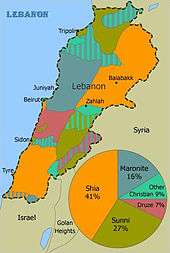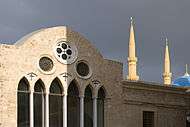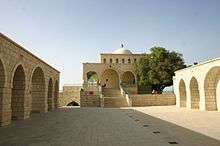Religion in Lebanon





Lebanon has several different main religions. The country has the most religiously diverse society of all states within the Middle East, comprising 18 recognized religious sects.[1] The main two religions are Islam (Shia and Sunni) with 54% of followers and Christianity (the Maronite Church, the Greek Orthodox Church, the Melkite Greek Catholic Church, the Protestant Church, the Armenian Apostolic Church) with 40.4% of followers. There is also the Druze minority religion, which under the Lebanese political division (Parliament of Lebanon Seat Allocation) the Druze community is designated as one of the five Lebanese Muslim communities (Sunni, Shia, Druze, Alawi, and Ismaili).[2][2]
No official census has been taken since 1932, reflecting the political sensitivity in Lebanon over confessional (i.e. religious) balance.[3]
The most recent study conducted by Statistics Lebanon, a Beirut-based research firm, found that approximately Lebanon's population is estimated to be 54% Muslim (27% Shia; 27% Sunni), 5.6% Druze, who do not consider themselves to be Muslims, 40.4% Christian (21% Maronite, 8% Greek Orthodox, 5% Melkite, 1% Protestant and 5.4% other Christian denominations like Armenian Orthodox, Armenian Catholic, Syriac Catholic, Syriac Orthodox, Roman Catholic, Chaldean, Assyrian, Copt).[4]
The CIA World Factbook estimates the following: Muslim 54% (27% Shia, 27% Sunni), Christian 40.5% (includes 21% Maronite Catholic, 8% Greek Orthodox, 5% Melkite Catholic, 1% Protestant, 5.5% other Christian), Druze 5.6%, very small numbers of Jews, Baha'is, Buddhists, Hindus, and Mormons.[5]
Lebanon also has a Jewish population, estimated at less than 100.
Legally registered Muslims form around 54% of the population (Shia, Sunni, Alawite). Legally registered Christians form up to 41% (Maronite, Greek Orthodox-Christian, Melkite, Armenian, Evangelical, other). Druze form around 5%.
Lebanon thus differs from other Middle Eastern countries where the Muslims are overwhelming majority and more resembles Bosnia-Herzegovina and Albania, both in Southeastern Europe, in having a diverse mix of Muslims and Christians that each make up approximately half the country's population.
Current political and religious issues
Under the terms of an agreement known as the National Pact between the various political and religious leaders of Lebanon, the president of the country must be a Maronite, the Prime Minister must be a Sunnite, and the Speaker of Parliament must be a Shiite.
Although Lebanon is a secular country, family matters such as marriage, divorce and inheritance are still handled by the religious authorities representing a person's faith. Calls for civil marriage are unanimously rejected by the religious authorities but civil marriages conducted in another country are recognized by Lebanese civil authorities.
Non-religion is not recognized by the state, the Minister of the Interior Ziad Baroud made it possible in 2009 to have the religious sect removed from the Lebanese identity card. This does not, however, deny the religious authorities complete control over civil family issues inside the country.[6][7]
Geographical distribution of sects in Lebanon
Lebanese Muslims
Lebanese Muslims are divided into many sects like Shiites, Sunnites, Druze, Alawites, and Ismailis.
Lebanese Shiites are concentrated in Southern Lebanon, Baalbek District, Hermel District and the south Beirut (southern parts of Greater Beirut).
Lebanese Sunnites are mainly residents of the major cities: west Beirut, Tripoli, and Sidon. Sunnis are also present in rural areas including Akkar, Ikleem al Kharoub, and the western Beqaa Valley.
Lebanese Druze are concentrated south of Mount Lebanon, in the Hasbaya District and Chouf District. Under the Lebanese political division (Parliament of Lebanon Seat Allocation) the Druze community is designated as one of the five Lebanese Muslim communities (Sunni, Shia, Druze, Alawi, and Ismaili).[2][2]
Lebanese Christians
Lebanese Christians are divided into many sects like Maronites, Orthodox, Melkites, and Protestants.
Lebanese Maronites are concentrated in the north Beirut (northern parts of Greater Beirut), northern part of Mount Lebanon Governorate, southern part of North Governorate, parts of Beqaa Governorate and South Governorate.[15]
Lebanese Orthodox are concentrated in the north Beirut (northern parts of Greater Beirut), Lebanese North areas including Zgharta, Bsharre, Koura, and Batroun.
Lebanese Protestants are concentrated mainly within the area of Beirut and Greater Beirut.
The other Lebanese Christians are concentrated also in similar areas like in east Beirut (northern parts of Greater Beirut), Mount Lebanon, Zahlé, and Jezzine.
Gallery
 Detail of the dome of the Khatem al-Anbiyaa Mosque in downtown Beirut
Detail of the dome of the Khatem al-Anbiyaa Mosque in downtown Beirut Saint George Eastern Orthodox Cathedral in downtown Beirut
Saint George Eastern Orthodox Cathedral in downtown Beirut- Saint George Greek Orthodox Cathedral on Nejme Square

 Druze Prophet of Job Shrine
Druze Prophet of Job Shrine
See also
- Christianity in Lebanon
- Islam in Lebanon
- Secularism in Lebanon
- Irreligion in Lebanon
- Freedom of religion in Lebanon
- Freemasonry in Lebanon
- Demographics of Lebanon
References
- ↑ Alfred B. Prados (June 8, 2006). 8, 2006)Update.pdf "Lebanon" Check
|url=value (help) (PDF). The Library of Congress. Retrieved June 11, 2012. - 1 2 3 4 Inc, Ibp (3 March 2012). "Lebanon Country Study Guide Volume 1 Strategic Information and Developments". Int'l Business Publications. Retrieved 10 July 2016 – via Google Books.
- ↑ Country Studies. "Lebanon Population". Retrieved November 25, 2006.
- ↑ "Statistics Lebanon Beirut-based research firm".
- ↑ "Lebanon". (July 2014 est.)
- ↑ Piero Gheddo (2009-02-13) LEBANON Religious affiliation to disappear from Lebanese documents – Asia News. Asianews.it. Retrieved on 2013-09-26.
- ↑ Religious Affiliation Can Be Removed From Lebanese ID Cards. Barcode Nation (2009-02-25). Retrieved on 2013-09-26.
- 1 2 agency, united states. central intelligence. "Contemporary distribution of Lebanon's main religious groups.". Retrieved 10 July 2016.
- 1 2
- 1 2
- 1 2 "Lebanon". Retrieved 10 July 2016.
- 1 2 "Lebanon". Retrieved 10 July 2016.
- 1 2 "The World Factbook". Retrieved 10 July 2016.
- 1 2 "Middle East :: LEBANON". CIA The World Factbook.
- ↑ Lebanon Maronites Overview World Directory of Minorities. June 2008. Retrieved 28 December 2013.
